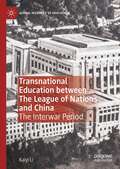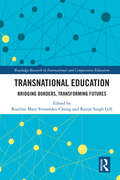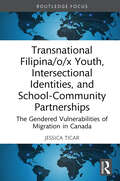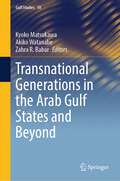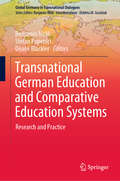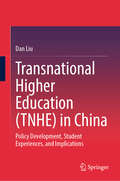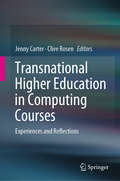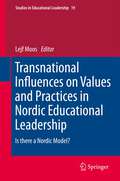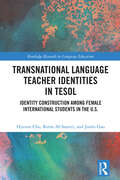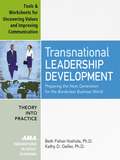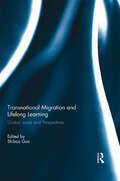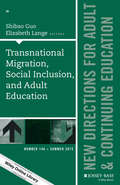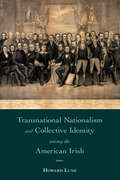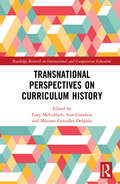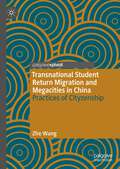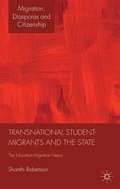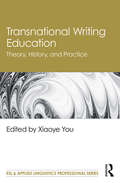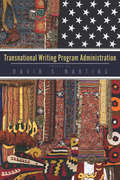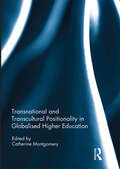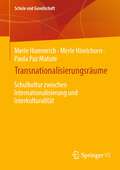- Table View
- List View
Transnational Education between The League of Nations and China: The Interwar Period (Global Histories of Education)
by Kaiyi LiThis volume examines transnational educational transfer between China and the League of Nations during the interwar period. By analysing the educational activities of the League of Nations with China, he book enriches the study of the history of the League of Nations by turning the focus to affairs that exceed the scope of traditional international relation and focusing on ways in which international organizations engaged in international educational endeavors. Adopting a transnational perspective, the book moves beyond conventional national-centered historiography, thus contributing to the understanding of how educational ideas, media, and policies circulate between different nations.
Transnational Education: Bridging Borders, Transforming Futures (Routledge Research in International and Comparative Education)
by Rozilini Mary Fernandez-Chung Ranjit Singh GillThis book explores the rapidly expanding world of cross-border education. As international student numbers have surged from 1.6 million in 2000 to over 6.4 million in 2022, transnational education (TNE) has become a transformative force in global higher education. This volume delves into how universities cross borders to deliver education, exploring models ranging from international branch campuses to digital learning platforms.Drawing on rich case studies from Asia, the Middle East, and beyond, the book examines four key dimensions of TNE: alignment with sustainable development goals, cross-border governance frameworks, regional cultural dynamics, and student experience. It offers a detailed analysis of established TNE markets like Malaysia and the Gulf states while uncovering developments in emerging hubs such as Sri Lanka and Vietnam. The contributors examine critical questions of quality assurance, cultural adaptation, and institutional partnerships that shape modern TNE. This book is an essential resource for policymakers, educators, and institutional leaders in an increasingly interconnected world. By offering practical strategies and forward-looking insights, it equips readers to navigate the complexities of TNE and leverage its potential to address pressing global challenges, from educational inequality to workforce development – a vital guide for shaping the future of international education.
Transnational Education: Issues and Trends in Offshore Higher Education
by Christopher Ziguras Grant McBurnieWhile the international mobility of students is a well-established feature of higher education, the international mobility of institutions and courses on a large scale is a more novel phenomenon. Transnational education is at the leading-edge of the most fundamental changes taking place in higher education today. Topics discussed in this new volume include: the extent and form of offshore activity the pedagogical and cultural controversies that have plagued transnational education the challenges it presents to governments, educators and HE managers how governments are developing forms of regulation to integrate cross-border programs and branch-campuses into their strategic planning for the sector the new opportunities for students and institutions. Transnational Education presents a global perspective on the development of international online education, partner-supported transnational programs and international branch campuses. It provides a comprehensive and analytical account of the active role some universities are playing on the international stage and offers valuable guidance on future trends in the sector.
Transnational Filipina/o/x Youth, Intersectional Identities, and School-Community Partnerships: The Gendered Vulnerabilities of Migration in Canada (Routledge Critical Studies in Gender and Sexuality in Education)
by Jessica TicarThis book provides an in-depth examination of how Filipina mothers, serving as migrant caregivers, and their children navigate the experiences of family separation and reunification through Canada’s Live-in/Caregiver Program (L/CP).It analyses how Filipina/o/x youth understand their political agency, the legacy of colonialism, and their sense of identity and belonging in urban schools through school-community partnerships. The work examines the global migration experiences of transnational Filipina/o/x youth and their mothers in nation-states such as Canada through the lens of the global domestic work industry. It connects the theoretical frameworks of critical and intersectional feminisms within a transnational context to the specificity of settler colonialism within Canada, a white settler nation-state. It underscores the pivotal role of school-community partnerships in facilitating the political agency of Filipina mothers and their children, and in shaping Filipina/o/x youths’ transnational identities through equitable educational policies and, ultimately, im/migration policies and practices. This book is a valuable addition to the discourse on global migration, transnational feminism, and critical race studies in education.The book primarily targets scholars, researchers, graduate students in the fields of Gender Studies, Education, Psychology, Mental Health, Immigration/Transnational Studies, and Asian Canadian Studies. It is particularly relevant for those with specialist knowledge in Gender and Immigration Studies, as well as Equity and Social Justice Education, which includes a focus on supporting the participation of racialized im/migrants in the school system.
Transnational Generations in the Arab Gulf States and Beyond (Gulf Studies #10)
by Zahra R. Babar Kyoko Matsukawa Akiko WatanabeThis book examines the recent migration phenomenon in the Arab Gulf states for work and residence. It sheds light on the transnationality of diverse groups of migrants from different generations, and unpacks how migrants’ multiple senses of belonging, orientations and adaptive strategies have shaped contemporary migration in the Gulf region. In turn, the analysis presented here shows how the Arab Gulf states’ citizenship and educational policies affect second-generation migrants in particular. Through a series of fine-grained ethnographic case studies, the authors demonstrate the ways in which these second-generation migrants construct their identities in relation to their putative ‘home’ country in the Gulf as well as their complex relationship to their parents’ countries of origin. This is what underpins the deeply transnational character of their lives, choices and notions of belonging. While migration scholars often situate these groups as ‘temporary’, this does not in fact capture the reality of temporariness for the migrants themselves, their children or their dependants. The result is a complex and ongoing construction of identity that shapes the way of life for millions of migrants. Relevant to scholars of migration and international studies, particularly focused on the Middle East, Transnational Generations in the Arab Gulf States and Beyond is also of interest to social scientists researching student mobility in higher education, intergenerational families, identity politics and globalisation.
Transnational German Education and Comparative Education Systems: Research and Practice (Global Germany in Transnational Dialogues)
by Benjamin Nickl Stefan Popenici Deane BlacklerThis book presents an in-depth look at the state of transnational education and comparative perspectives on education systems between Germany and other nation states. It explores how a transnational education identity in secondary and tertiary institutions has developed in the German and other national contexts and which lessons can be learned from current challenges and successes of education systems. It uses detailed case studies to promote critical rethinking of current educational practices in high schools and universities, specifically of race, gender, religion and learner ability in educational settings. It understands learning and teaching as an arena to discuss transnational education opportunities in the 21st century as an emerging or evolving discourse on contemporary forms of transnationalism.
Transnational Higher Education (TNHE) in China: Policy Development, Student Experiences, and Implications
by Dan LiuThis book provides an in-depth analysis of the motivations, experiences, and challenges that Chinese students face in transnational higher education (TNHE). It traces their educational journey-from their initial motivations for seeking TNHE to their graduate employment-while exploring the academic, social, and cultural dimensions of their experiences. Readers will gain a nuanced understanding of Chinese students&’ engagement with TNHE, both within China and at later stages abroad. The book offers valuable insights for educators, policymakers, and researchers, providing a strong foundation for addressing the challenges and opportunities associated with TNHE in China. Additionally, it serves as a key resource for those interested in enhancing Chinese students&’ perceptions of and experiences in TNHE programmes. Beyond practical implications, this book contributes to the theorisation of TNHE, teacher development, and research methodologies in the field.
Transnational Higher Education in Computing Courses: Experiences and Reflections
by Jenny Carter Clive RosenThere has been exponential growth in transnational education (TNE) in the last few years as UK universities have looked to expand their markets. Recipient countries have sought short cuts to developing their higher education provision which has proved a lucrative income stream for some universities. But overseas collaborations are not without risk. Recipient countries can be concerned with external influence over curricula, quality being diluted and higher education being infected by neo-imperialism. These concerns are not without foundation. There are risks for providers too. Reputations can be damaged if academic standards are compromised. Conflicts of interest can occur between quality of provision and the pot of gold on offer. Staff can view overseas collaborations as distracting from their research and commitment to home students. Computing is a particularly popular subject for TNE, but critical thinking, analysis, independent learning, and creativity can be compromised. Preventing plagiarism is difficult. Constant changes in technology result in constant curricula revision which causes severe problems for overseas collaborations. This book focuses on TNE in the computing domain. However cross-cultural issues challenge TNE management and administration whatever the subject area. If the ever present tensions are not continuously monitored they can quickly threaten the sustainability of the collaboration. This book identifies many of the threats and some of the solutions. The readership for this book is truly global. Any international development officer in higher education considering an overseas collaboration will benefit from this book. Any academic becoming engaged in, or already involved with a TNE partnership, either as provider or recipient, will gain information and insight into the practice and issues. Researchers in TNE will discover more lines of enquiry. Students considering a course with an overseas provider or in coming to the UK to study will be better prepared thereby enabling a more fulfilling and rewarding experience. Anyone who has an interest in TNE, whether at the senior executive level, operational level, delivering programmes or as a recipient of TNE should read this book. The wealth of experience gathered here will provoke questions, prompt debate and offer solutions. It has been written by people who know the issues, bear the scars and are happy to share their knowledge. It will greatly benefit future transnational collaborations.
Transnational Higher Education in the Asian Context
by Tricia Coverdale-JonesThis book offers new insights and perspectives on internationalization and trans-national higher education (TNHE) with contributions from three continents. These include the student experience in Malaysia, China, Japan and India as well as institutional perspectives and pedagogical implications of new research.
Transnational Influences on Values and Practices in Nordic Educational Leadership
by Lejf MoosThis book explores to what extent transnational influences change national/local values and practices in the Nordic educational systems. It provides country cases and thematic chapters that give nuanced insights into the influence of transnational agencies on national governance and discourses. It describes how national discourses and regulation influences school leadership values, culture and practice, in competition with traditional values. The transnational and global discourse on educational leadership is mostly formed according to Anglo-American thinking and tradition. Pivotal foundations of this discourse are strong hierarchical societies/class societies with liberal democracies, and clearly streamed education systems. The Nordic discourse, however, builds on a more equal society and flat hierarchies with participatory democracy, and on comprehensive schooling with strong local community roots. Leadership thinking and practices are formed by the culture and context they are part of: they are primarily shaped by the national/local values, traditions and practices, and only partially shaped by politics, discourses and literature. Due to the fact that a great deal of the literature that is being used in the Nordic contexts is of Anglo-American origin and many of the research projects have Anglo-American foundations, it is difficult to distinguish the sources for leadership thinking and practice. This book distinguishes the Nordic from the Anglo-American thinking and presents important findings and arguments for leadership practitioners inside as well as outside the Nordic countries.
Transnational Language Teacher Identities in TESOL: Identity Construction Among Female International Students in the U.S. (Routledge Research in Language Education)
by Hyesun Cho Reem Al-Samiri Junfu GaoDrawing on Bakhtin’s notion of ideological becoming and the concepts of intersectionality and transnationalism, this volume offers a unique conceptual framework to explore and better understand the identity construction and negotiation of international TESOL students. Focusing on female graduate students studying in the U.S., the text utilizes rich narratives to illustrate how nuanced language teacher identities develop through complex dialogic processes relating to language, race, and gender—as well as migration experiences—and individuals’ integration in academic and professional communities. Ultimately, the text contests deficit reductionist views of transnational students that are implied by educational policies and administration. This text will benefit scholars, academics, and students in the fields of bilingualism, TESOL, multicultural education, and language identity more broadly. Those involved with teaching and teacher education, as well as language and culture in general, will also benefit from this book.
Transnational Leadership Development: An HR Practioner's Guide to Transformative Learning in Employee Development - Appendix 2
by Beth Fisher-Yoshida Kathy D. GellerTransnational Leadership Development acquaints readers with the paradoxes and mental processes leaders need to relate successfully to people with different backgrounds, cultures, and societal identities. This appendix helps translate the transformative learning process into a process that HR professionals can use in employee interventions and learning experiences. It explains six dynamics necessary to provide a context for an intervention plus examples of how to apply it to conflict management.
Transnational Leadership Development: Tools and Worksheets for Uncovering Values and Improving Communication - Appendix 1
by Beth Fisher-Yoshida Kathy D. GellerTransnational Leadership Development acquaints readers with the paradoxes and mental processes leaders need to relate successfully to people with different backgrounds, cultures, and societal identities. This appendix includes tools to facilitate communication including a social identity map, values charts, reflection worksheets, strategy planning tools, a dialog model, guided questions and tips.
Transnational Migration and Lifelong Learning: Global Issues And Perspectives
by Shibao GuoEconomic globalization, modern transportation, and advanced communication technologies have greatly enhanced the mobility of people across national boundaries. The resulting demographic, social, and cultural changes create new opportunities for development as well as new challenges for lifelong learning. Transnational Migration and Lifelong Learning examines the changing nature of lifelong learning in the current age of transnational migration. The book brings together international scholars from a range of countries in a dialogue about the relationship between work, learning, mobility, knowledge, and citizenship in the context of globalization and migration. It covers a wide range of topics, including: global perspectives and analyses of migration; the impact of migration on lifelong learning; processes of exclusion and inclusion in lifelong learning; the tension between mobility, knowledge, and recognition; and transnationalism, learning communities, and citizenship. This book was originally published as a special issue of the International Journal of Lifelong Education.
Transnational Migration, Social Inclusion, and Adult Education: New Directions for Adult and Continuing Education, Number 146 (J-B ACE Single Issue Adult & Continuing Education)
by Shibao Guo Elizabeth LangeAs a result of transnational migration, many countries are becoming increasingly ethnoculturally diverse, creating both new opportunities and challenges for practices of adult education. This volume examines the changing nature of adult education in the age of increased transnational migration and: • synthesize the latest research, policies, and practices in transnational migration and adult education, • examines the larger historical and structural issues of race and gender in immigration and newer theories, such as diaspora studies, in relation to adult education, and • provides examples and recommendations for enhancing socially just and inclusive adult education environments for newcomers. Transborder injustices and multiple dimensions of social justice permeate immigration dynamics and challenge adult educators to rethink social justice in a transnational age.This is the 146th volume of the Jossey Bass series New Directions for Adult and Continuing Education. Noted for its depth of coverage, it explores issues of common interest to instructors, administrators, counselors, and policymakers in a broad range of education settings, such as colleges and universities, extension programs, businesses, libraries, and museums.
Transnational Nationalism and Collective Identity among the American Irish
by Howard LuneIn Transnational Nationalism and Collective Identity among the American Irish, Howard Lune considers the development and mobilization of different nationalisms over 125 years of Irish diasporic history (1791–1920) and how these campaigns defined the Irish nation and Irish citizenship. Lune takes a collective approach to exploring identity, concentrating on social identities in which organizations are the primary creative agent to understand who we are and how we come to define ourselves. As exiled Irishmen moved to the United States, they sought to create a new Irish republic following the American model. Lune traces the construction of Irish American identity through the establishment and development of Irish nationalist organizations in the United States. He looks at how networks—such as societies, clubs, and private organizations—can influence and foster diaspora, nationalism, and nationalist movements. By separating nationalism from the physical nation, Transnational Nationalism and Collective Identity among the American Irish uniquely captures the processes and mechanisms by which collective identities are constructed, negotiated, and disseminated. Inevitably, this work tackles the question of what it means to be Irish—to have a nationality, a community, or a shared history.
Transnational Perspectives on Curriculum History (Routledge Research in International and Comparative Education)
by Ivor Goodson Gary McCulloch Mariano González-DelgadoThis book offers a remarkable range of research that emphasises the need to analyse the shaping of curricula under historical, social and political variables. Teachers’ life stories, the Cold War as a contextual element that framed curricular transformations in the US and Europe, and the study of trends in education policy at transnational level are issues addressed throughout. The book presents new lines of work, offering multidisciplinary perspectives and provides an overview of how to move forwards. The book brings together the work of international specialists on Curriculum History and presents research that offers new perspectives and methodologies from which to approach the study of the History of Education and Educational Policy. It offers new debates which rethink the historical study of the curriculum and offers a strong interdisciplinary approach, with contributions across Education, History and the Social Sciences. This book will be of great interest for academics and researchers in the fields of education and curriculum studies. It will also appeal to educational professionals, teachers and policy makers.
Transnational Student Return Migration and Megacities in China: Practices of Cityzenship
by Zhe WangThis book is a study of the return migration of overseas Chinese students. By 2018, over 3.5 million Chinese students had returned from overseas universities to China, with the megacities of Beijing, Shanghai, and Shenzhen representing by far their main destinations. In other words, when overseas students return to China, many do not return to their hometown but usually land, work and settle down in Beijing, Shanghai and Shenzhen. Their return migration is thus not only transnational, but also internal-urban. This book adopts a multi-level geographical analysis to explore this important phenomenon, exploring why and how returnees choose these three cities and how they experience and interpret their everyday lives in these megacities after their return. In doing so, it highlights the importance of cultural logics and multiscalar thinking of transnational Chinese students’ return migration and illuminates how their transnational migration reproduces domestic socio-spatial inequalities. This book brings an important contribution to the fields of Cultural Geography, Urban Geography, Transnationalism, Migration Studies and Citizenship Studies.
Transnational Student-Migrants and the State
by Shanthi RobertsonInternational students are often engaged not just in education, but in high stakes towards gaining permanent migration status. This book unpacks the consequences of this education-migration nexus, analyzing migration policies and providing a vivid picture of student-migrants' lived experiences.
Transnational Synergies in School Mathematics and Science Debates (Palgrave Studies in Excellence and Equity in Global Education)
by Margaret Walshaw Roger OpenshawThis book highlights and interrogates the continued interest and scrutiny of mathematics and science education. National debates on excellence and equity tend to focus largely on underachievement in mathematics and science rather than subjects in the arts or music: this is due to a belief that these curriculum areas are central to individual workplace success and national development in a competitive economic environment. The authors explore the history of these assumptions, as well as the debates based around claims that student achievement levels in these subjects has fallen. Spanning the United States, New Zealand, Australia and the United Kingdom, the chapters question how such debates are sustained and amplified: how has this perceived ‘crisis’ been articulated and spread across national borders? This comprehensive book will be of interest and value to scholars of mathematics and science education, as well as international education debates.
Transnational Writing Education: Theory, History, and Practice (ESL & Applied Linguistics Professional Series)
by Xiaoye YouArguing that writing teachers need to enable students to recognize, negotiate with, deconstruct, and transcend national, racial, ethnic, and linguistic boundaries, this volume proposes a "transnational" framework as an alternative approach to literacy education and as a vital component to cultivating students as global citizens. In a field of evolving literacy practices, this volume builds off the three pillars of transnational writing education—translingualism, transculturalism, and cosmopolitanism—and offers both conceptual and practice-based support for scholars, students, and educators in order to address current issues of inclusion, multilingual learning, and diversity.
Transnational Writing Program Administration (G - Reference, Information And Interdisciplinary Subjects Ser.)
by David S. MartinsWhile local conditions remain at the forefront of writing program administration, transnational activities are slowly and thoroughly shifting the questions we ask about writing curricula, the space and place in which writing happens, and the cultural and linguistic issues at the heart of the relationships forged in literacy work. Transnational Writing Program Administration challenges taken-for-granted assumptions regarding program identity, curriculum and pedagogical effectiveness, logistics and quality assurance, faculty and student demographics, innovative partnerships and research, and the infrastructure needed to support writing instruction in higher education. Well-known scholars and new voices in the field extend the theoretical underpinnings of writing program administration to consider programs, activities, and institutions involving students and faculty from two or more countries working together and highlight the situated practices of such efforts. The collection brings translingual graduate students at the forefront of writing studies together with established administrators, teachers, and researchers and intends to enrich the efforts of WPAs by examining the practices and theories that impact our ability to conceive of writing program administration as transnational. This collection will enable writing program administrators to take the emerging locations of writing instruction seriously, to address the role of language difference in writing, and to engage critically with the key notions and approaches to writing program administration that reveal its transnationality.
Transnational and Borderland Studies in Mathematics Education (Studies in Mathematical Thinking and Learning Series)
by Richard S. Kitchen Marta CivilEvery year, significant numbers of immigrant children from Mexico enter classrooms in the United States. These immigrants comprise a heterogeneous group of students with diverse needs, abilities, and experiences. Transnational and Borderland Studies in Mathematics Education is the first collection to offer research studies across these communities. Providing invaluable research on both sending and receiving communities in Mexico and the US, this collection considers the multiple aspects of children’s experiences with mathematics, including curriculum, classroom participation structures, mathematical reasoning and discourse – both in and out of school – and parents’ perceptions and beliefs about mathematics instruction. An important treatment of an insufficiently documented subject, this collection brings together researchers on both sides of the border to foster and support an interest in documenting evidence that will set the stage for future studies in mathematics education.
Transnational and Transcultural Positionality in Globalised Higher Education
by Catherine MontgomeryTransnational higher education (TNHE), where students study on a ‘foreign’ degree programme whilst remaining in their home country, has seen exponential development over the last decade. In addition to the increase in students engaged in TNHE across the globe, the involvement of university teachers in TNHE has also risen in response to the demand for this form of international education. Although research into transnational education has doubled since 2006, there is a paucity of research focusing on transnational teacher education, especially outside of North America. The global nature and scope of the expansion of TNHE remains underexplored, and the ways in which different countries are realising TNHE provision is little understood. This book explores the experiences and perceptions of teachers in transnational higher education, interrogating the ways in which university teachers negotiate cultural, linguistic, and disciplinary contexts in order to provide transformative learning experiences for their students. This book was originally published as a special issue of the Journal of Education for Teaching.
Transnationalisierungsräume: Schulkultur zwischen Internationalisierung und Interkulturalität (Schule und Gesellschaft #65)
by Merle Hummrich Merle Hinrichsen Paula Paz MatuteDas Buch zeigt die pädagogische Bedeutung von Globalisierungsprozessen in der Institution Schule. Diese lässt sich anhand von zwei Dimensionen markieren: der Internationalisierung von Schule und der Relevanz von ethnischer Diversität. Wie sich Schulkulturen auf diese Prozesse beziehen und wie sie damit einhergehende Anforderungen bearbeiten, wird theoretisch mit dem Konzept der Transnationalisierung aufgeschlüsselt. Zudem wird herausgearbeitet welche Möglichkeitsräume für Bildungsteilhabe sich in diesem Zusammenhang für Jugendliche eröffnen.
